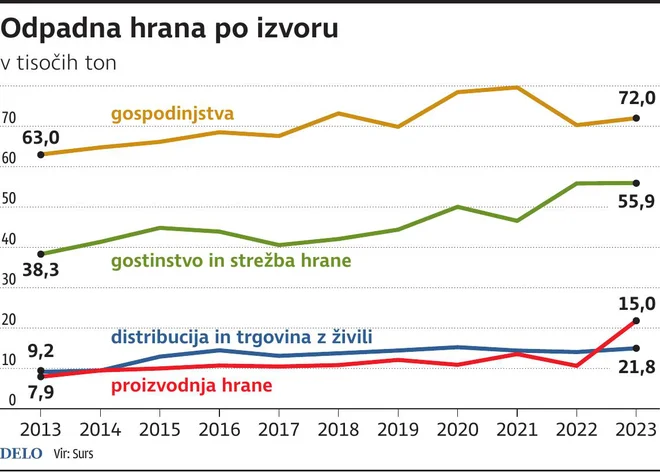The amounts of waste food are still growing, and more and more edible during waste

Despite the frequent calls and raising awareness, the amount of waste food in Slovenia is increasing. In 2023, nine percent more waste food was created than the year before, and the growth was recorded in most activities with the exception of catering.
According to the National Statistical Office, the average resident of Slovenia in 2023 discarded 78 kilograms of food. Almost half, 44 percent, from a total of just under 165,000 tonnes of waste food was made in households, a third in the hospitality and hospitality and serving, 13 percent in food production, and 9 percent in grocery store. While the formation of a particular part of waste food (bones, bones and eggshells …) is difficult to prevent, with our actions we can primarily affect the reduction of the amounts of edible work. According to statistics, the proportion of this in waste food is 37 percent or 29 kilograms of food per capita.
The Consumers Association of Slovenia believes that strategic orientations and activities of the government in the field of reducing waste food, which include, among other things, the preparation of a strategy for less food loss and the inclusion of compulsory donated food in the proposal for a new food law, shifts in the right direction. However, they estimate that you should further strengthen them. As he said to the STA Matjaz Pircwe need a clear political commitment to « no waste food », the coordinated functioning of all stakeholders in the food chain and even more concrete, ambitious measures.
The proportion of edible food between waste is increasing.
They donate more than 2000 tonnes of food a year, with staffing strengths.
Caterers can reduce discounts by monitoring the quantities.
He also agrees with that Gaja Brecelj from the non -governmental environmental organization Umanotera. He points out the importance of awareness at the level of public institutions, such as schools and kindergartens, where habits are created, which are later reflected in household behavior.
Infographics: Work
When donated to system solutions
The Ministry of the Environment collects data on the quantity and composition of waste food with two approaches: a sorting analysis of bio -waste and with kitchen waste food logs in households. The latest sorting analysis performed in the Fall – Winter 2024/2025 in seven areas in the Podravska region, points out a worrying trend: it is increasingly edible during waste food. The edible part of waste food increased by eight percent and accounts for 24.4 percent of waste waste.
One of the key measures to reduce the amount of waste food is the donation of surpluses, which also has humanitarian significance. With the help of about 350 volunteers, more than 2000 tonnes of food donated, donated by about 130 stores to about 12,000 people annually, participants of the national consultation on Slovenian day without discarded food. In donation brokers, they warned the need to introduce systemic staffing, which would allow more effective redistribution of larger amounts of donated food and help reduce the amount of edible food that ends during waste.
Hospitality also has great potential for reducing waste food. The Ecologists Without Borders Association presented the project conclusions for less waste and more sustainable nutrition in the catering sector. Analysis of waste food, menus, purchasing policies and communication at three participating restaurants has shown that the amounts of waste food calculated are between 150 and 460 grams. Restaurants can already reduce this amount by measuring the quantities of discarded food. Three projects included reduced by six to 18 percent. In Slovenia, we can boast good practices described in the newly issued guidelines for the catering sector.
Tenth of emissions associated with waste food
Waste food is one of the biggest global problems. While 733 million people around the world suffer from hunger, one year is lost or landed among waste of food produced for human consumption, representing one billion meals per day. The largest part or 60 percent of waste food is generated in households, according to the UN Food World Program data.
It is estimated to be between eight and ten percent of global greenhouse gas emissions associated with food that ends in the trash. The methane produced by the rotting of food in the landfills 84 times more affect the warming of the atmosphere than the carbon dioxide, the problem of waste food was written on the portal Our common food.







